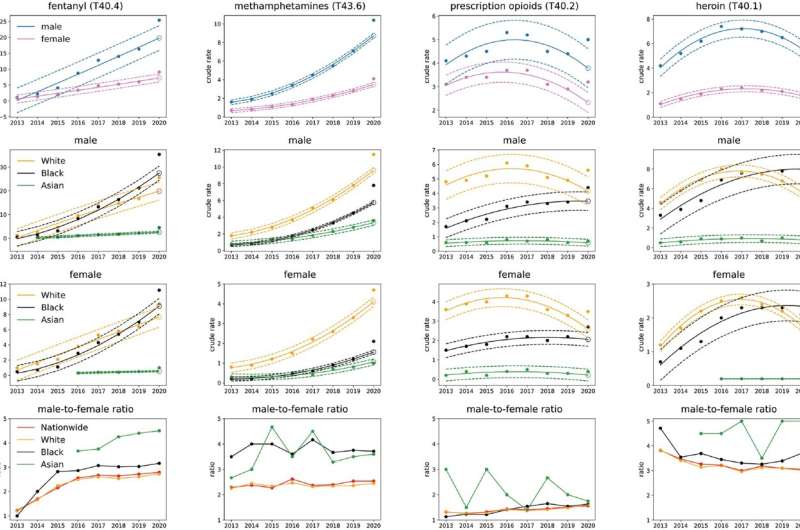This article has been reviewed according to Science X's editorial process and policies. Editors have highlighted the following attributes while ensuring the content's credibility:
fact-checked
peer-reviewed publication
trusted source
proofread
Racial disparities in US drug overdose fatalities significantly higher in 2020, shows study

The first year of the COVID pandemic saw significant increases in drug overdose deaths across the U.S., with rates higher than recent trends could have predicted.
Research published in PLOS Global Public Health reports trends in drug overdose deaths between 2013 and 2020 across four major drug categories by gender, race and geography. It finds high levels of heterogeneity in overdose patterns across different demographic groups and that the gap in overdose fatalities between Black and white individuals continues to widen. Drug prevention and mitigation campaigns should therefore be tailored to specific at-risk groups.
Drug overdose deaths have been increasing in the U.S. for the past two decades. Since 2013 a "third wave" of overdose fatalities has arisen, with a shift from prescription opioids and towards synthetic ones, in particular illicit fentanyl. Researchers from UCLA, the California State University at Northridge, and the Frankfurt School of Finance and Management, used the National Vital Statistics System multiple cause-of-death mortality files, extracting rates by race and gender in all 50 states plus the District of Columbia. Profs. Maria R. D'Orsogna, Lucas Böttcher and Tom Chou considered the impact of four main drug categories of psychostimulants with addiction potential such as methamphetamines; heroin; prescription opioids, and synthetic opioids such as fentanyl and its derivatives.
They found significant increases in overdose deaths from all categories except heroin in 2020, with data surpassing predictions derived from 2013-2019 trends. Rates among Black individuals of both genders exceeded those for white individuals for fentanyl and psychostimulants starting in 2018; the gap continued to widen in the years since. The largest 2020 death rate is for Black males in the District of Columbia due to fentanyl with a rate almost 10 times higher than that for white males.
The authors believe that pandemic-related anxieties and a greater availability of cheaper drugs that may be easily ordered online contributed to the rise in fatal overdoses. They argue that drug prevention strategies should include racial, geographical and gender-specific efforts to better identify and serve at-risk groups.
Dr. D'Orsogna says, "The third wave of drug overdose deaths began in 2013 with the arrival of fentanyl on the illicit drug market. Although overdose deaths have steadily increased since then, the pandemic year 2020 saw a significant rise of fatalities in many states."
Dr. Böttcher adds, "Perhaps most surprising to us were the results for the District of Columbia. Here, the 2020 fentanyl-induced mortality was 134 deaths per 100,000 Black male residents but only 14 deaths per 100,000 white male residents. These disparities existed even prior to the pandemic, and are seen in other states as well, such as Illinois or Missouri."
Dr. Chou notes, "To effectively combat the drug epidemic, given the large heterogeneity of fatality rates, it is essential that we conduct more local-level studies and better understand the unique needs of specific groups, as well as the ways in which culture, socio-economic factors, and geographic conditions influence substance use."
More information: Maria R. D'Orsogna et al, Fentanyl-driven acceleration of racial, gender and geographical disparities in drug overdose deaths in the United States, PLOS Global Public Health (2023). DOI: 10.1371/journal.pgph.0000769



















